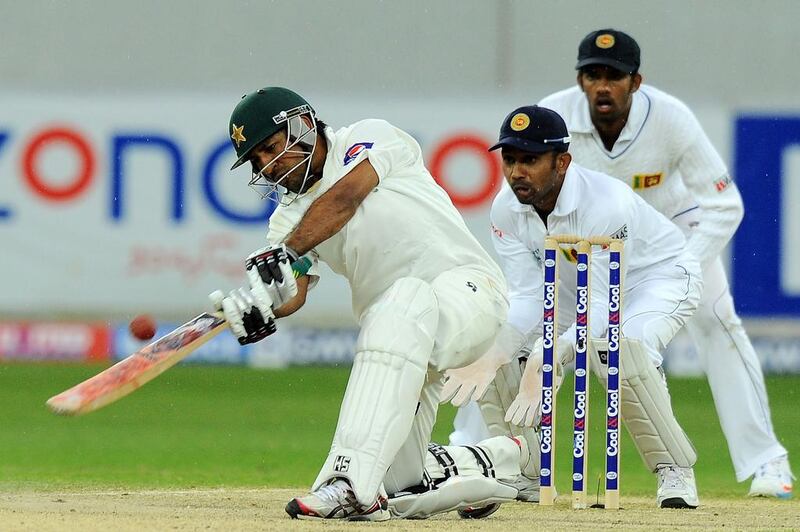DUBAI // Sometimes it really does feel like Test cricket does not want to help itself.
Reality trumped parody ahead of yesterday’s play when the ground authorities cordoned off the prime viewing area behind the bowler’s arm at Dubai International Cricket Stadium.
All the comfy seats at the Sports City End were out of commission for the small contingent of cricket-loving public who had bothered to make the effort to come to watch.
It was all on account of the batsmen complaining the day before about people walking around spoiling their perspective, no matter the fact that the area is about 10 metres above the generously-sized sight-screen set aside for their benefit.
If Mohammed Irfan stood on Courtney Walsh’s shoulders, he might have been releasing the ball from around that space. Rangana Herath, the spinner who is not much more than 1.5m tall in long-spikes, was not.
Do not worry about the spectator experience, though.
So long as the players are happy, that is the main thing.
It begs the question quite what they would have done had the ground been full.
Or even any fuller than 90 per cent empty. But let us not worry about that, it will never be a problem with this format of the sport on its current course.
Even with barely anyone to police, the ground’s security team can find a way of being overzealous. Turns out you cannot walk up the entry ramp reserved for VVIP cars on the Motor City side of the ground.
Safety risk, apparently. Quite why, who knows? You cannot stand there, you cannot walk there, you cannot sit there.
Maybe they should station snipers on the roof to take out any spectators who attempt to risk enjoying themselves next time, just to make sure.
Then counter in the important bit, the fact the majority of the cricket could not have been of lower intensity if it was being played in shock absorbers.
Take, for instance, the 88th over of the Pakistan innings, which took 13 minutes to bowl. For no obvious reason.
The fielders thought the ball was out of shape. The umpires had a conflab and, while everyone decided whether it was round or not and where they were going to get a new one from – if it was needed at all – they decided a drinks break was necessary.
Then at the day’s end, just before drizzle fittingly curtailed events, Kumar Sangakkara – one of four wicketkeepers in the Sri Lankan XI – came on to bowl. At least it provided some levity amid the gloom.
This was listless fare, and surely not sport that anyone would want to pay to watch.
At times like these, what you probably do not need is Misbah-ul-Haq. Or maybe that misses the point.
Maybe it is his weight-of-the-world cussedness – if not his forward defensive stroke – which the few who had bothered to make the journey had come to see.
There is a quiet heroism in the way a man can go for more than an hour without doing the thing he is supposed to do, namely score runs.
Pakistan’s captain did not trouble the scorers until after the morning drinks break. Yet it sums up the strangeness of Test cricket that it was more or less just what his team needed.
He blunted Sri Lanka’s bowlers and ensured there was not the two-wicket burst that Graham Ford, the opposing coach, had suggested was needed in the freshness of the morning.
That he later fell three runs short of his century was harsh for everyone. On a leaden day for Test cricket, its supporters could have done with something to cheer.
pradley@thenational.ae
Follow us on Twitter at @SprtNationalUAE






